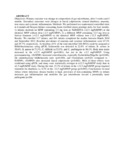Effects of high and low dose iron-containing micronutrient powders for in-home fortification of complementary foods on the gut microbiome and gut inflammation in kenyan infants

View/
Date
2015Author
Jaeggi, Tanja
Kortman, Guus
Moretti, Diego
Chassard, Christophe
Holding, Penny
Dostal, Alexandra
Boekhorst, Jos
Timmerman, Harro
[et al.]
Language
enMetadata
Show full item recordAbstract
Objectives: Primary outcome was change in composition of gut microbiome, after 3 weeks and 4 months. Secondary outcomes were changes in faecal calprotectin, treated diarrhoea, anaemia, iron status and systemic inflammation.
Methods: We performed two randomized controlled trials in 6-month-old Kenyan infants consuming home-fortified maize porridge daily for four months. 1) infants received an MNP containing 2.5 mg iron as NaFeEDTA (+2.5 mgFeMNP) or the identical MNP without iron (-2.5 mgFeMNP). 2) a different MNP containing 12.5 mg iron as ferrous fumarate (+12.5 mgFeMNP) or the identical MNP without iron (-12.5 mgFeMNP).
Results: We enrolled 117 infants, and 101 infants completed the studies between March 2010 and September 2012. Baseline prevalence of anaemia and systemic inflammation were 67.3% and 29.7%, respectively. At baseline, 63% of the total microbial 16S rRNA could be assigned to Bifidobacteriaceae; using qPCR, Salmonella was detected in 22.8% of infants, B. cereus in 38.6%, S. aureus in 71.3%, C. difficile in 53.5%, and C. perfringens in 86.1%. Body iron stores increased in the +12.5 mgFeMNP (p=0.001), but not in the +2.5 mgFeMNP. Using pyrosequencing, +FeMNPs increased enterobacteria, especially Escherichia/Shigella (p=0.048), the enterobacteria/ bifidobacteria ratio (p=0.020), and Clostridium (p=0.03) compared to -FeMNPs; +FeMNPs also increased faecal calprotectin (p=0.002). Most of these effects were confirmed using qPCR, and many were statistically stronger in ±12.5 mgFeMNP study than in ±2.5 mgFeMNP study. During the trial, 27.3% of infants in the +12.5 mgFeMNP group required treatment for diarrhoea vs. 8.3% in the -12.5 mgFeMNP group (p=0.092).
Conclusions: In rural Africa where infectious disease burden is high, provision of iron-containing MNPs to infants increases gut inflammation and modifies the gut microbiome toward a potentially more pathogenic profile
